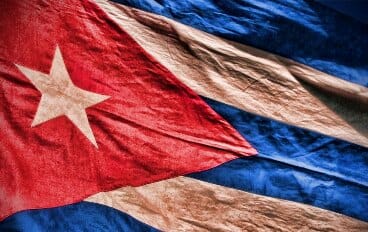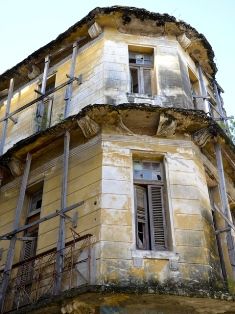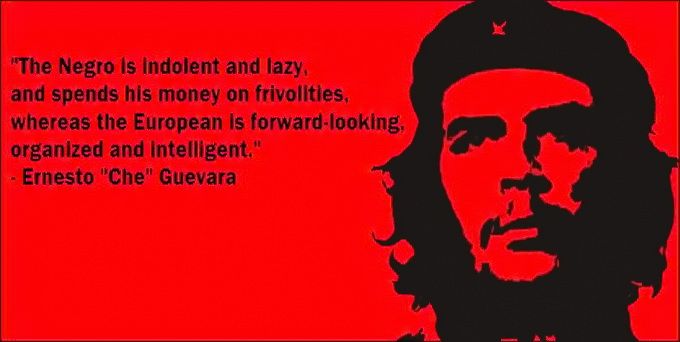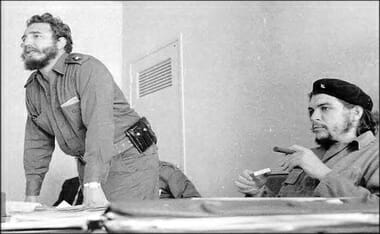Before the WONDERFUL article…
…one should also consider C-SPANs interview “Book Discussion on Fidel: Hollywood’s Favorite Tyrant” ~ the discussing Cuba, Fidel, Che Guevara, and their “useful idiots,” is Humberto Fontova. His Amazon.com page has three books on Cuba available. Here is the truncated video interview:
- Inside the BookTV Bus, Humberto Fontova was interviewed about his book Fidel: Hollywood’s Favorite Tyrant, published by Regnery Publishing. He spoke about the media’s affixation with the Cuban dictator. Mr. Fontova also discussed political prisoners and a decline in health care.
I want to say, firstly, our of all the politically/culturally minded journals I subscribe to, The City Journal is by far the best, if one were to subscribe to one journal, this would be it. Here are a few excerpts from the article, “The Last Communist City: A visit to the dystopian Havana that tourists never see“
…Marxists have ruled Cuba for more than a half-century now. Fidel Castro, Argentine guerrilla Che Guevara, and their 26th of July Movement forced Fulgencio Batista from power in 1959 and replaced his standard-issue authoritarian regime with a Communist one. The revolutionaries promised liberal democracy, but Castro secured absolute power and flattened the country with a Marxist-Leninist battering ram. The objectives were total equality and the abolition of money; the methods were total surveillance and political prisons. The state slogan, then and now, is “socialism or death.”
Cuba was one of the world’s richest countries before Castro destroyed it—and the wealth wasn’t just in the hands of a tiny elite. “Contrary to the myth spread by the revolution,” wrote Alfred Cuzan, a professor of political science at the University of West Florida, “Cuba’s wealth before 1959 was not the purview of a privileged few. . . . Cuban society was as much of a middle-class society as Argentina and Chile.” In 1958, Cuba had a higher per-capita income than much of Europe. “More Americans lived in Cuba prior to Castro than Cubans lived in the United States,” Cuban exile Humberto Fontova, author of a series of books about Castro and Guevara, tells me. “This was at a time when Cubans were perfectly free to leave the country with all their property. In the 1940s and 1950s, my parents could get a visa for the United States just by asking. They visited the United States and voluntarily returned to Cuba. More Cubans vacationed in the U.S. in 1955 than Americans vacationed in Cuba. Americans considered Cuba a tourist playground, but even more Cubans considered the U.S. a tourist playground.” Havana was home to a lot of that prosperity, as is evident in the extraordinary classical European architecture that still fills the city. Poor nations do not—cannot—build such grand or elegant cities.
But rather than raise the poor up, Castro and Guevara shoved the rich and the middle class down. The result was collapse. “Between 1960 and 1976,” Cuzan says, “Cuba’s per capita GNP in constant dollars declined at an average annual rate of almost half a percent. The country thus has the tragic distinction of being the only one in Latin America to have experienced a drop in living standards over the period.”
Communism destroyed Cuba’s prosperity, but the country experienced unprecedented pain and deprivation when Moscow cut off its subsidies after the fall of the Soviet Union. Journalist and longtime Cuba resident Mark Frank writes vividly about this period in his book Cuban Revelations. “The lights were off more than they were on, and so too was the water. . . . Food was scarce and other consumer goods almost nonexistent. . . . Doctors set broken bones without anesthesia. . . . Worm dung was the only fertilizer.” He quotes a nurse who tells him that Cubans “used to make hamburgers out of grapefruit rinds and banana peels; we cleaned with lime and bitter orange and used the black powder in batteries for hair dye and makeup.” “It was a haunting time,” Frank wrote, “that still sends shivers down Cubans’ collective spines.”…
Some equate Cuba to Iraq or Afghanistan. The author of the article, after being told this by a fellow travelor responded to this in the article:
I visited Iraq seven times during the war and didn’t have the heart to tell her that Baghdad, while ugly and dangerous, is vastly freer and more prosperous these days than Havana. Anyway, Iraq is precisely the kind of country with which Castro wants you to compare Cuba. It’s the wrong comparison. So are impoverished Third World countries like Guatemala and Haiti. Cuba isn’t a developing country; it’s a once-developed country destroyed by its own government. Havana was a magnificent Western city once. It should be compared not with Baghdad, Kabul, Guatemala City, or Port-au-Prince but with formerly Communist Budapest, Prague, or Berlin. Havana’s history mirrors theirs, after all.
[….]
…As for the free health care, patients have to bring their own medicine, their own bedsheets, and even their own iodine to the hospital. Most of these items are available only on the illegal black market, moreover, and must be paid for in hard currency—and sometimes they’re not available at all. Cuba has sent so many doctors abroad—especially to Venezuela, in exchange for oil—that the island is now facing a personnel shortage. “I don’t want to say there are no doctors left,” says an American man who married a Cuban woman and has been back dozens of times, “but the island is now almost empty. I saw a banner once, hanging from somebody’s balcony, that said, DO I NEED TO GO TO VENEZUELA FOR MY HEADACHE?”
Housing is free, too, but so what? Americans can get houses in abandoned parts of Detroit for only $500—which makes them practically free—but no one wants to live in a crumbling house in a gone-to-the-weeds neighborhood. I saw adequate housing in the Cuban countryside, but almost everyone in Havana lives in a Detroit-style wreck, with caved-in roofs, peeling paint, and doors hanging on their hinges at odd angles.
Education is free, and the country is effectively 100 percent literate, thanks to Castro’s campaign to teach rural people to read shortly after he took power. But the regime has yet to make a persuasive argument that a totalitarian police state was required to get the literacy rate from 80 percent to 100 percent. After all, almost every other country in the Western Hemisphere managed the same feat at the same time, without the brutal repression.
Cuba is short of everything but air and sunshine. In her book, Sánchez describes an astonishing appearance by Raúl Castro on television, during which he boasted that the economy was doing so well now that everyone could drink milk. “To me,” Sánchez wrote, “someone who grew up on a gulp of orange-peel tea, the news seemed incredible.” She never thought she’d see the day. “I believed we would put a man on the moon, take first place among all nations in the upcoming Olympics, or discover a vaccine for AIDS before we would put the forgotten morning café con leche, coffee with milk, within reach of every person on this island.” And yet Raúl’s promise of milk for all was deleted from the transcription of the speech in Granma, the Communist Party newspaper. He went too far: there was not enough milk to ensure that everyone got some.
Even things as simple as cooking oil and soap are black-market goods. Individuals who, by some illegal means or another, manage to acquire such desirables will stand on street corners and whisper “cooking oil” or “sugar” to passersby, and then sell the product on the sly out of their living room. If they’re caught, both sellers and buyers will be arrested, of course, but the authorities can’t put the entire country in jail. “Everyone cheats,” says Eire. “One must in order to survive. The verb Ωto steal≈ has almost vanished from usage. Breaking the rules is necessary. Resolví mi problema, which means ‘I solved my problem,’ is the Cuban way of referring to stealing or cheating or selling on the black market.”
Cuba has two economies now: the national Communist economy for the majority; and a quasi-capitalist one for foreigners and the elite…
[….]
…The Floridita bar in downtown Havana was one of Ernest Hemingway’s hangouts when he lived there (from 1940 until 1960, the year after Castro came to power). He was in the Floridita all the time—and, in a way, he still is. There’s a statue of him sitting on his favorite bar stool, grinning at today’s patrons. The décor is exactly the same, but there’s a big difference: everyone in the bar these days is a tourist. Cubans aren’t strictly banned any more, but a single bottle of beer costs a week’s salary. No one would blow his dismal paycheck on that.
If he were still around, Hemingway would be stunned to see what has happened to his old haunt. Cubans certainly aren’t happy about it, but the tourists are another story—especially the world’s remaining Marxoid fellow travelers, who show up in Havana by the planeload. Such people are clearly unteachable. I got into an argument with one at the Floridita when I pointed out that none of the patrons were Cuban. “There are places in the United States that some can’t afford,” she retorted. Sure, but come on. Not even the poorest Americans have to pay a week’s wage for a beer…
[….]
…An advertisement in my hotel claimed that the Sierra Maestra restaurant on the top floor is “probably” the best in Havana. I had saved the Sierra Maestra for my last night and rode the elevator up to the 25th floor. I had my first and only steak on the island and washed it down with Chilean red wine. The tiny bill set me back no more than having a pizza delivered at home would, but the total nevertheless exceeded an entire month’s local salary. Not surprisingly, I ate alone. Every other table was empty. The staff waited on me as if I were the president of some faraway minor republic.
I stared at the city below out the window as I sipped my red wine. Havana looked like a glittering metropolis in the dark. Night washed away the rot and the grime and revealed nothing but city lights. It occurred to me that Havana will look mostly the same—at night, anyway—after it is liberated from the tyrannical imbeciles who govern it now. I tried to pretend that I was looking out on a Cuba that was already free and that the tables around me were occupied—by local people, not foreigners—but the fantasy faded fast. I was all alone at the top of Cuba’s Elysium and yearning for home—where capitalism’s inequalities are not so jagged and stark.
You Should READ It All!
John Stossle & Daily Beast:
Cuban’s in L.A. Fighting Castro:
Sen. Marco Rubion on Jay-Z:
Other Worthwhile Articles:














